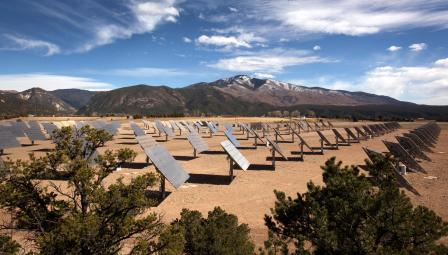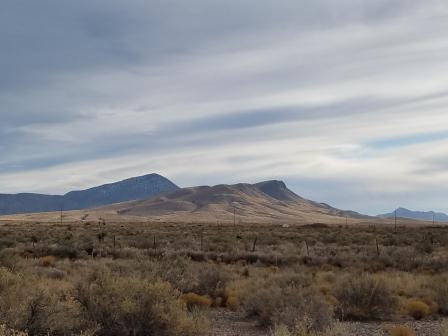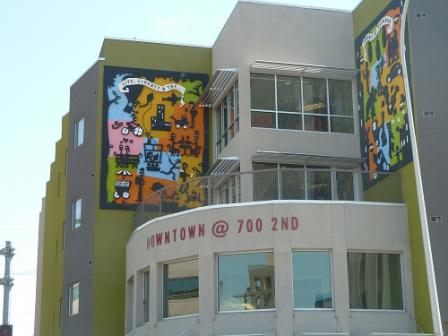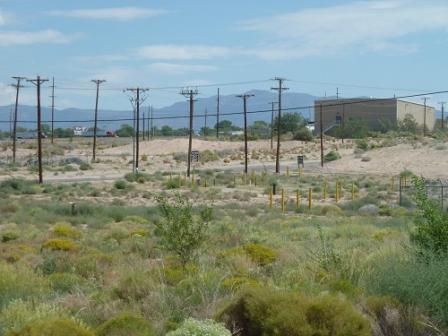Superfund Sites in Reuse in New Mexico
If you are having trouble viewing the map in your browser, click the 'View larger map' link below
AT & SF (Clovis)
The 140-acre AT&SF (Clovis) Superfund site is located in Clovis, New Mexico. Since the early 1900s, stormwater and wastewater discharge from a nearby railyard contaminated surface water, sediment and soil. EPA placed the site on the National Priorities List (NPL) in 1983. Cleanup activities completed in 2000 included excavation and treatment of sediment and placement of treated sediments in a capped on-site storage facility. Cleanup also included bioremediation of soil, fencing, and institutional controls. The site is located over the Ogallala Aquifer, which is a source of drinking water for the city of Clovis. The site also includes Santa Fe Lake. On-site areas were also restored with native grasses and provide habitat for migratory birds.
Last updated September 2019
As of December 2019, EPA did not have economic data related to on-site businesses, or economic data were not applicable due to site use. For additional information click here.
For more information:
Chevron Questa Mine 
 Chevron Questa MineThe Chevron Questa Mine Superfund site is located in Taos County, New Mexico. The site includes a former molybdenum mine, milling facility and tailing impoundments. The former mine is four miles east of the village of Questa (Questa) on State Highway 38. The former milling facility is nine miles east of Questa on State Highway 38. The tailing impoundments are located in Questa. Mining operations began in 1920. Chevron Mining (CMI), formerly Molycorp, ceased mining operations in June 2014. Open-pit mining on site resulted in the excavation of over 328 million tons of waste rock, which was placed on rock piles around the open pit. Stormwater runoff also carried mining waste over land, contaminating sediments in local surface water bodies, including Eagle Rock Lake. EPA placed the site on the National Priorities List (NPL) in 2011. Cleanup activities include excavating and disposing of contaminated soil; regrading, covering, and revegetating waste rock piles; and covering and revegetating tailing impoundments. Activities also included installing groundwater recovery systems, treating groundwater, installing stormwater controls, dredging, providing a temporary alternate water supply, placing drilling restrictions, and dewatering the underground mine. In 2010, Chevron Technology Ventures built a solar facility on 20 acres of the site. The facility produces about 1 megawatt of energy annually, enough to power about 150 homes. The facility has been operational since April 2011. Kit Carson Electric Cooperative is purchasing the electricity under a 20-year agreement. CMI and other stakeholders also partnered to restore Eagle Rock Lake, a valued community resource. The Red River hatchery routinely stocks the lake with trout. The lake’s surroundings offer trails, picnic areas and restroom facilities. Some mine cleanup efforts include a portion of the site managed by the U.S. Forest Service (USFS). The federally-managed USFS property has been the focus of habitat preservation and restoration work. In September 2017, EPA Region 6 presented its Greenovations Award to Chevron Environmental Management Company, USFS, the New Mexico Department of Game and Fish, Questa, and Chevron project contractors Arcadis and ENTACT for their efforts at Eagle Rock Lake.
Chevron Questa MineThe Chevron Questa Mine Superfund site is located in Taos County, New Mexico. The site includes a former molybdenum mine, milling facility and tailing impoundments. The former mine is four miles east of the village of Questa (Questa) on State Highway 38. The former milling facility is nine miles east of Questa on State Highway 38. The tailing impoundments are located in Questa. Mining operations began in 1920. Chevron Mining (CMI), formerly Molycorp, ceased mining operations in June 2014. Open-pit mining on site resulted in the excavation of over 328 million tons of waste rock, which was placed on rock piles around the open pit. Stormwater runoff also carried mining waste over land, contaminating sediments in local surface water bodies, including Eagle Rock Lake. EPA placed the site on the National Priorities List (NPL) in 2011. Cleanup activities include excavating and disposing of contaminated soil; regrading, covering, and revegetating waste rock piles; and covering and revegetating tailing impoundments. Activities also included installing groundwater recovery systems, treating groundwater, installing stormwater controls, dredging, providing a temporary alternate water supply, placing drilling restrictions, and dewatering the underground mine. In 2010, Chevron Technology Ventures built a solar facility on 20 acres of the site. The facility produces about 1 megawatt of energy annually, enough to power about 150 homes. The facility has been operational since April 2011. Kit Carson Electric Cooperative is purchasing the electricity under a 20-year agreement. CMI and other stakeholders also partnered to restore Eagle Rock Lake, a valued community resource. The Red River hatchery routinely stocks the lake with trout. The lake’s surroundings offer trails, picnic areas and restroom facilities. Some mine cleanup efforts include a portion of the site managed by the U.S. Forest Service (USFS). The federally-managed USFS property has been the focus of habitat preservation and restoration work. In September 2017, EPA Region 6 presented its Greenovations Award to Chevron Environmental Management Company, USFS, the New Mexico Department of Game and Fish, Questa, and Chevron project contractors Arcadis and ENTACT for their efforts at Eagle Rock Lake.
Last updated September 2019
As of December 2019, EPA had data on one on-site business. EPA did not have further economic details related to this business. For additional information click here.
For more information:
- Site Redevelopment Profile: Eagle Rock Lake and the Chevron Questa Mine Superfund Site (PDF)(2 pp, 1.4 MB)
- Redevelopment of the Molycorp Inc., Superfund Site (PDF)(1 pg, 128 K, About PDF)
- New Energies: Utility-Scale Solar on a Tailing Disposal Facility, Chevron Questa Mine Superfund Site in Questa, New Mexico (PDF)(16 pp, 6.7 MB)
- Superfund Site Profile Page
- Eagle Rock Lake Restoration
- Superfund Greenovations Award
Cimarron Mining Corp.
 Cimarron Mining Corp.The 18-acre Cimarron Mining Corporation Superfund site is located in Carrizozo, New Mexico. The site includes two areas – the 10.6-acre Cimarron Mill site and the 7.5-acre Sierra Blanca Mill site. From 1960 to 1982, milling operations at the sites contaminated soil, sediment and groundwater. EPA placed the site on the National Priorities List (NPL) in 1989. EPA dug up and stabilized contaminated soil with cement and placed it in two on-site disposal areas at the Sierra Blanca Mill site. EPA then capped and revegetated the disposal areas. EPA removed and disposed of drums, tanks and associated piping off site. At the Cimarron Mill site, EPA extracted and discharged contaminated groundwater to the publicly owned treatment works. An auto repair shop and salvage yard are located at the Cimarron Mill site, which is fenced to restrict access. The Sierra Blanca Mill site is fenced and available for reuse, except for the two capped disposal cells.
Cimarron Mining Corp.The 18-acre Cimarron Mining Corporation Superfund site is located in Carrizozo, New Mexico. The site includes two areas – the 10.6-acre Cimarron Mill site and the 7.5-acre Sierra Blanca Mill site. From 1960 to 1982, milling operations at the sites contaminated soil, sediment and groundwater. EPA placed the site on the National Priorities List (NPL) in 1989. EPA dug up and stabilized contaminated soil with cement and placed it in two on-site disposal areas at the Sierra Blanca Mill site. EPA then capped and revegetated the disposal areas. EPA removed and disposed of drums, tanks and associated piping off site. At the Cimarron Mill site, EPA extracted and discharged contaminated groundwater to the publicly owned treatment works. An auto repair shop and salvage yard are located at the Cimarron Mill site, which is fenced to restrict access. The Sierra Blanca Mill site is fenced and available for reuse, except for the two capped disposal cells.
Last updated September 2019
As of December 2019, EPA had data on one on-site business. EPA did not have further economic details related to this business. For additional information click here.
For more information:
Fruit Avenue Plume 
 Fruit Avenue PlumeThe Fruit Avenue Plume Superfund site consists of contaminated groundwater under part of downtown Albuquerque, New Mexico. Between 1924 and 1958, Sunshine Laundry operated on site. In 1940, the owner expanded laundry services to include dry cleaning. In April 1989, routine sampling by the city of Albuquerque (City) found contamination in the groundwater. Site investigators determined that past dry-cleaning processes were the cause of the contamination. EPA added the site to the National Priorities List (NPL) in 1999. Cleanup activities included pumping and treatment of contaminated groundwater and monitoring of natural processes to clean up groundwater. Collaboration by the New Mexico Environment Department, EPA and a local developer helped support the site property’s return to use as a green housing development. Established in 2010, the housing development includes 72 micro-efficiency units. These affordable housing units exceed baseline Green Communities Criteria. Enterprise Community Partners, a national nonprofit, set the criteria. Green features include a rooftop array of solar panels for domestic hot water and supplemental space heating, cisterns for roof water collection, a greywater reuse system, low-emitting materials and low water plants. The building has an outdoor courtyard with a community garden for resident use. A hospitality center operates a coffee shop on site and provides job training for formerly homeless community members. In 2017, EPA’s Superfund Redevelopment Initiative provided support to facilitate discussions between EPA and the City to remove or relocate groundwater remedy components to accommodate additional development. Additional development in the area of the former groundwater treatment plant is underway. A coffee shop and coffee roasting business is currently operating in the former Maloof Distributor building. Plans include dining, a brewery, a distillery, retail housing and parking. Discussions are underway with the New Mexico Department of Transportation and BNSF Railway to develop a rails-to-trails system near Glorieta Station. EPA continues to work with the state and community members supporting reuse opportunities in the area.
Fruit Avenue PlumeThe Fruit Avenue Plume Superfund site consists of contaminated groundwater under part of downtown Albuquerque, New Mexico. Between 1924 and 1958, Sunshine Laundry operated on site. In 1940, the owner expanded laundry services to include dry cleaning. In April 1989, routine sampling by the city of Albuquerque (City) found contamination in the groundwater. Site investigators determined that past dry-cleaning processes were the cause of the contamination. EPA added the site to the National Priorities List (NPL) in 1999. Cleanup activities included pumping and treatment of contaminated groundwater and monitoring of natural processes to clean up groundwater. Collaboration by the New Mexico Environment Department, EPA and a local developer helped support the site property’s return to use as a green housing development. Established in 2010, the housing development includes 72 micro-efficiency units. These affordable housing units exceed baseline Green Communities Criteria. Enterprise Community Partners, a national nonprofit, set the criteria. Green features include a rooftop array of solar panels for domestic hot water and supplemental space heating, cisterns for roof water collection, a greywater reuse system, low-emitting materials and low water plants. The building has an outdoor courtyard with a community garden for resident use. A hospitality center operates a coffee shop on site and provides job training for formerly homeless community members. In 2017, EPA’s Superfund Redevelopment Initiative provided support to facilitate discussions between EPA and the City to remove or relocate groundwater remedy components to accommodate additional development. Additional development in the area of the former groundwater treatment plant is underway. A coffee shop and coffee roasting business is currently operating in the former Maloof Distributor building. Plans include dining, a brewery, a distillery, retail housing and parking. Discussions are underway with the New Mexico Department of Transportation and BNSF Railway to develop a rails-to-trails system near Glorieta Station. EPA continues to work with the state and community members supporting reuse opportunities in the area.
Last updated September 2019
As of December 2019, EPA did not have economic data related to on-site businesses, or economic data were not applicable due to site use. For additional information click here.
For more information:
Lea and West Second Street
The Lea and West Second Street Superfund site is located in the city of Roswell in Chavez County, New Mexico. The Superfund site includes four locations (Sites 1 through 4) near West Second Street and East Second Street. At Sites 1 through 4, historical industrial operations are documented. Operations released hazardous substances to the soil. The hazardous substances then migrated to groundwater. EPA added the site to the National Priorities List (NPL) in 2016. Site investigations are ongoing. The site includes commercial and residential areas near the center of downtown Roswell. These areas remain in continued use. An educational facility also operates on site.
Last updated September 2019
As of December 2019, EPA did not have economic data related to on-site businesses, or economic data were not applicable due to site use. For additional information click here.
For more information:
McGaffey and Main Groundwater Plume
The 550-acre McGaffey and Main Groundwater Plume Superfund site is located in Roswell, New Mexico. From 1956 to 1976, several dry-cleaning businesses operated on South Main Street. These former businesses used tetrachloroethylene (PCE) in their daily operations. In 1994, the New Mexico Environment Department (NMED) discovered contaminants in groundwater samples. Further studies linked the contaminated groundwater to the former dry-cleaning operations. NMED led immediate cleanup actions and connected affected residents to the public water supply. NMED also installed groundwater monitoring wells. EPA added the site to the National Priorities List (NPL) in 2002. In 2008, EPA selected a cleanup plan to address risks from chemical vapors entering buildings through the soil. The cleanup plan also aims to restore groundwater quality to drinking water standards. EPA built a vapor intrusion mitigation system to reduce chemical vapors in buildings. EPA also built an enhanced soil vapor extraction system to remove vapors from soil and a central treatment facility. Once funding is approved, groundwater cleanup will begin in the source area. NMED is investigating groundwater contamination beyond the source area and will design a cleanup plan to address this. NMED also does regular community outreach to inform public well users not to use groundwater for drinking water. The cleanup approach successfully controls human exposure to remaining contamination. Continued land uses at the site include commercial businesses, public services, residential areas, industrial operations and agricultural uses. Commercial and municipal uses at the former dry-cleaning properties are ongoing. One former on-site dry-cleaning property has been removed and a car wash has been developed on the property.
Last updated September 2019
As of December 2019, EPA had data on 11 on-site businesses. These businesses employed 92 people and generated an estimated $6,836,176 in annual sales revenue. For additional information click here.
For more information:
North Railroad Avenue Plume
The 58-acre North Railroad Avenue Plume site is located in Española, New Mexico. The Norge Town laundromat and dry-cleaning operation contaminated groundwater with tetrachloroethylene (PCE), trichloroethylene (TCE), cis-1,2-dichloroethylene (DCE) and trans-1,2-DCE. EPA added the site to the National Priorities List (NPL) in 1999. The remedy consists of enhanced in-situ bioremediation, which uses microbes to clean up contaminated soil and groundwater. The areas targeted for cleanup are the source area, hot spot soils, and areas of shallow and deep groundwater. Land uses over the plume include a park-and-ride transit facility for the North Central Regional Transit District. Future uses planned for the area include a community arts center and food hub.
Last updated September 2019
As of December 2019, EPA did not have economic data related to on-site businesses, or economic data were not applicable due to site use. For additional information click here.
For more information:
South Valley 
 South ValleyThe South Valley Superfund site is located in an industrial area of Albuquerque, New Mexico. The site includes two main areas – the former Air Force Plant 83 site (also referred to as the GEA site) and the Univar site. Beginning in the 1950s, various companies operated two facilities on the Air Force Plant 83 site. General Electric Aviation took over in 1984. Parties demolished the facilities in 1997 and 2011. Companies have used the Univar site for commercial and industrial purposes since the 1960s. Since 1985, Univar USA, a chemicals distribution company, has been active at the Univar site. Studies found contamination in soil and groundwater resulting from manufacturing practices. EPA placed the South Valley site on the National Priorities List (NPL) in 1983. Cleanup actions at the former Air Force Plant 83 (GEA) site included soil and groundwater treatment. Off-site groundwater treatment and monitoring are ongoing. Cleanup actions at the Univar site include ongoing groundwater treatment. In 2011, after General Electric Aviation closed its jet engine component plant on site, the company committed to recycling or reusing all usable building materials. This effort kept over 14,000 tons of building materials out of local landfills. It also significantly reduced demolition costs. Bernalillo County has developed plans for a connector road between Interstate 25 and the Albuquerque airport. This road will cross the site. The County anticipates that the road will ease traffic and attract new businesses to the area. The project is currently being designed and is anticipated to begin construction in 2020. EPA is currently reviewing the possibility of deleting part of the site from the NPL.
South ValleyThe South Valley Superfund site is located in an industrial area of Albuquerque, New Mexico. The site includes two main areas – the former Air Force Plant 83 site (also referred to as the GEA site) and the Univar site. Beginning in the 1950s, various companies operated two facilities on the Air Force Plant 83 site. General Electric Aviation took over in 1984. Parties demolished the facilities in 1997 and 2011. Companies have used the Univar site for commercial and industrial purposes since the 1960s. Since 1985, Univar USA, a chemicals distribution company, has been active at the Univar site. Studies found contamination in soil and groundwater resulting from manufacturing practices. EPA placed the South Valley site on the National Priorities List (NPL) in 1983. Cleanup actions at the former Air Force Plant 83 (GEA) site included soil and groundwater treatment. Off-site groundwater treatment and monitoring are ongoing. Cleanup actions at the Univar site include ongoing groundwater treatment. In 2011, after General Electric Aviation closed its jet engine component plant on site, the company committed to recycling or reusing all usable building materials. This effort kept over 14,000 tons of building materials out of local landfills. It also significantly reduced demolition costs. Bernalillo County has developed plans for a connector road between Interstate 25 and the Albuquerque airport. This road will cross the site. The County anticipates that the road will ease traffic and attract new businesses to the area. The project is currently being designed and is anticipated to begin construction in 2020. EPA is currently reviewing the possibility of deleting part of the site from the NPL.
Last updated September 2019
As of December 2019, EPA had data on one on-site business. This business employed 8 people and generated an estimated $11,655,000 in annual sales revenue. For additional information click here.
For more information:
